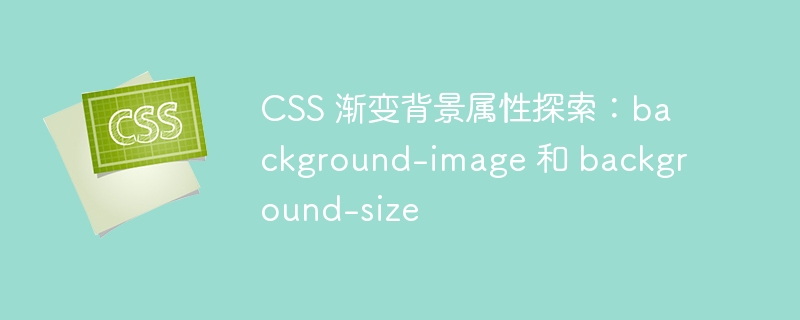Home >Web Front-end >CSS Tutorial >Exploring CSS gradient background properties: background-image and background-size
Exploring CSS gradient background properties: background-image and background-size
- PHPzOriginal
- 2023-10-20 14:51:381394browse

Exploration of CSS gradient background properties: background-image and background-size
Background is a very important element in web design, which can give the page a richer visual effect . In the past, you could set the background color for an element by using the background-color property in CSS, but in modern web design, developers can achieve cooler effects through the CSS gradient background property. This article will focus on exploring two key CSS properties: background-image and background-size, and give specific code examples.
The background-image attribute is used to set the background image of the element. In the past, developers would need to use the a1f02c36ba31691bcfe87b2722de723b tag in HTML to add a background image, but this method required additional network requests and increased page load time. Through the background-image attribute, developers can directly set the background image in CSS, reducing network requests and improving page loading speed.
The syntax of the background-image attribute is as follows:
background-image: url('图片路径');Among them, url('picture path') specifies the background image to be used. Developers can directly use the path of the image as a parameter, or they can use relative paths or absolute paths.
In addition to using a single image as the background, we can also use gradient effects to create a cooler background. CSS provides two types of gradient effects: linear gradients and radial gradients.
Linear gradient creates a gradient effect by specifying a starting point and an ending point, and two or more color values. The syntax is as follows:
background-image: linear-gradient(方向, 颜色值1, 颜色值2, ...);
Among them, the direction can be an angle value (such as 45deg) or a direction keyword (such as to right, to bottom). The color value can be a specific color value (such as #ff0000) or a color keyword (such as red, blue).
For example, we can create a red gradient background from top to bottom:
background-image: linear-gradient(to bottom, red, #ff0000);
A radial gradient is created by specifying one or more points and taking the color as the radius and offset. Create a gradient effect. The syntax is as follows:
background-image: radial-gradient(点位置1, 颜色值1, 点位置2, 颜色值2, ...);
Among them, the point position can be a length value (such as 10px, 50%) or a keyword (such as top, left, center). Color values can be specific color values or color keywords.
For example, we can create a radial gradient background that spreads outward from the center:
background-image: radial-gradient(circle, red, #ff0000);
The size of the background image can be adjusted through the background-size property to fit the size of the background area. The syntax of the background-size attribute is as follows:
background-size: 宽度 高度;
Among them, the width and height can be specific pixel values (such as 200px, 100%) or keywords (such as cover, contain).
For example, we set the background image to a size of 200px × 200px, using the cover keyword to keep the proportions adapted to the background area:
background-size: 200px 200px; background-size: cover;
By using the background-image and background-size properties, develop The user can create richer and more diverse background effects. Explore and try out a variety of different gradients and background images to create unique web designs. I hope the content of this article will be helpful to you, and you are welcome to try and innovate in practical applications!
The above is the detailed content of Exploring CSS gradient background properties: background-image and background-size. For more information, please follow other related articles on the PHP Chinese website!

